
Creating winter interest in the garden is so important, and is one of the things I consider first when designing a new garden.
Especially since most of my designs are located in our temperate zone 9 climate, (which means our gardens are on display every single day of the year.)
There’s no hiding our winter garden under a forgiving blanket of snow – it’s right there staring us in the face!
And without some thoughtful plant placement and plant choices, January and February can be downright depressing.
So, before your garden begins to spring back into action, go outside and take a good, hard look at it.
Are you happy with what you see?
Or does it look like a winter moonscape, with far too many deciduous plants.
Here are some of my favorite design strategies to help give you a beautiful, year-round garden (yes, even in January!)
Since I have so much to share with you on this topic, I’m breaking this post into two parts (click here for Part 2.)
1. Structure and Form are key for the winter garden

Winter is a fantastic time to assess the structure (or lack thereof) in your garden.
Structure (also known as the bones of the garden) is what holds it together on the bleakest of days.
Whether year-round form comes from living plants or non-living elements, a garden’s structure is what will let it shine in the winter.
Unfortunately, a common scenario with beginning gardeners is their focus isn’t on long-term, year-round interest but instead on immediate gratification provided by the colorful and overflowing nursery aisles.
And who could blame them- we’ve all been there, right?
While new gardeners are thrilled with their beds in May and June (when most plants are in full bloom), they quickly become frustrated and disappointed with their garden’s performance throughout the rest of the year.
More often than not, the cause of their dismay is the garden’s lack of form.

If your garden’s colorful tapestry seems a little threadbare in the winter, perhaps it needs an injection of a bold, evergreen form, such as the round Blue Spruce or triangular Dwarf Alberta Spruce.
Not only do strong forms have the strength and volume to stand up to oppressive mounds of snow, but even when covered with a blanket of white, they’ll continue to provide attractive shapes in the garden.
Can you imagine how gorgeous the round form of this Blue Spruce would look dusted with snow?
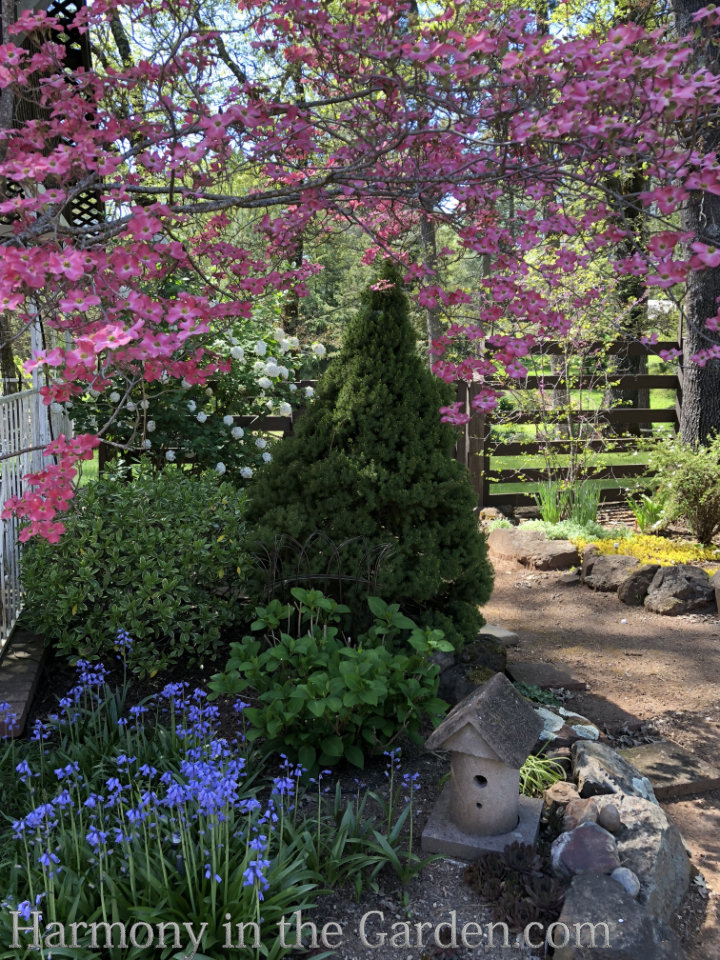
Here’s a fantastic example of a 4-Season Garden Bed, using the Dwarf Alberta Spruce to provide structure.
In the spring, all eyes are on the pink dogwood and the blue Spanish bluebell flowers. No one’s really paying attention to the triangular-shaped spruce.
And in the summer (below left) the focus shifts to those amazing blue hydrangea flowers.
In the fall, (below right) the attention is on the blazing burning bush and the dogwood leaves.

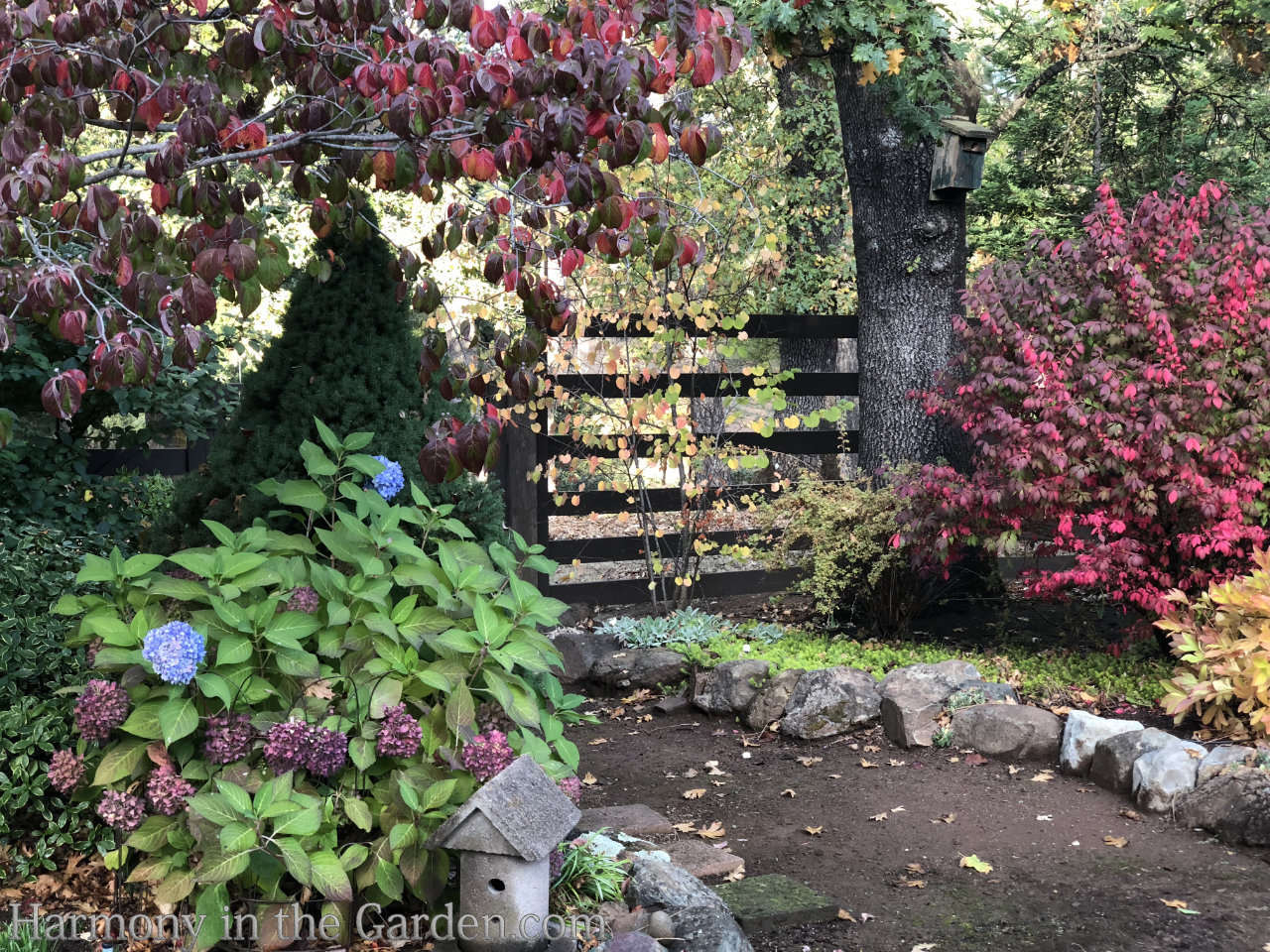

But in the winter, thank heavens for that spruce!
While many of the surrounding trees and plants are dormant, it’s the hefty form of the spruce that provides the necessary winter structure.
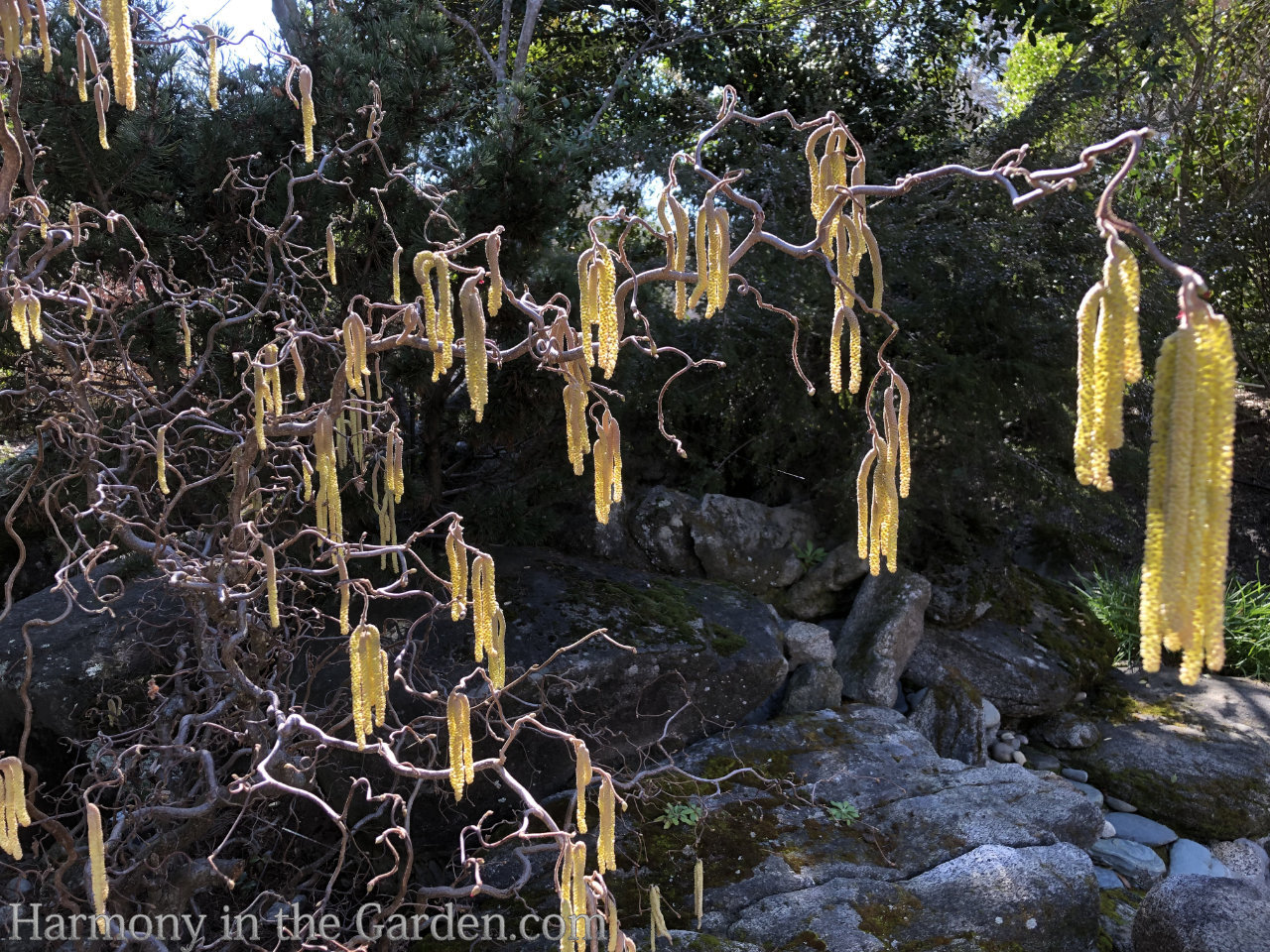
It’s not just evergreen shrubs that give structure to a garden.
Many deciduous plants also have the necessary shapes and lines to provide a garden with winter structure.
In fact, during the winter months, the lines of many dormant plants actually look their best.
For example, take the twisting branches of Harry Lauder’s Walking Stick (Corylus avellana ‘Contorta’.)
Its branches are hidden with fairly uninteresting leaves during the summer months, but once winter arrives, it takes center stage with its unique curlicue branches and earring-like catkins.

The same thing goes for the incredible shape of this very old Japanese Maple.
I’m sure it’s stunning when in leaf, but it’s downright magical in the depth of winter.
2. Avoid the dreaded winter wasteland
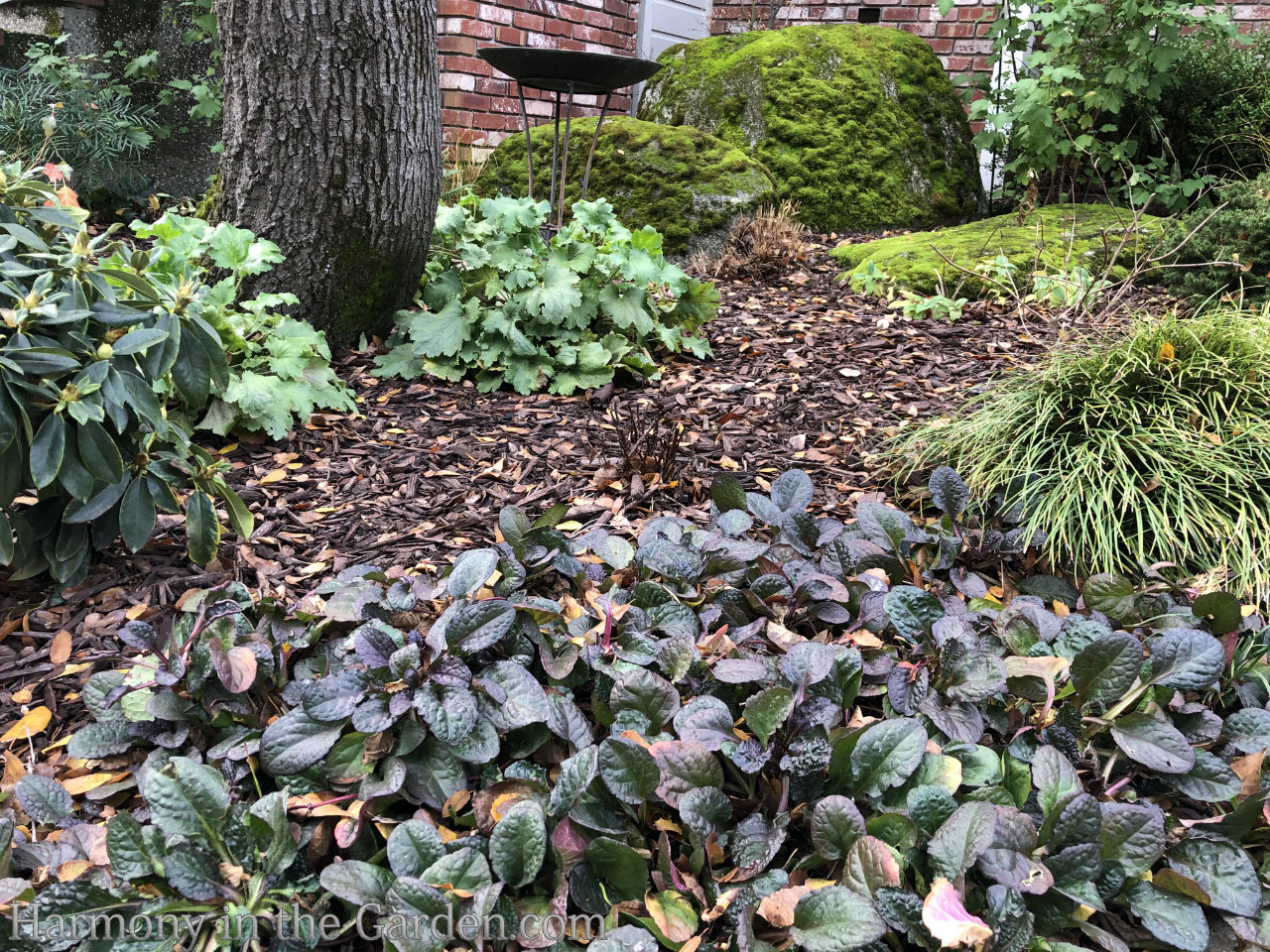
With each plant I select for the garden, I imagine how it’ll look in January and February.
Will it be dormant, completely hidden from sight? Will it leave a ‘hole’ in the garden bed?
If so, I’ll make sure to surround it with a few evergreen plants that will provide an element of interest until spring arrives once again.
When too many of these ‘holes’ are next to one another, the Winter Moonscape makes its dreaded appearance.
In the photo (left) you can see a hole left by a dormant perennial, however the surrounding evergreen plants keep things interesting.
In the example below, take a look at how the evergreen plants provide winter interest (lower, right) despite the long-gone flowers and dormant Japanese maple.

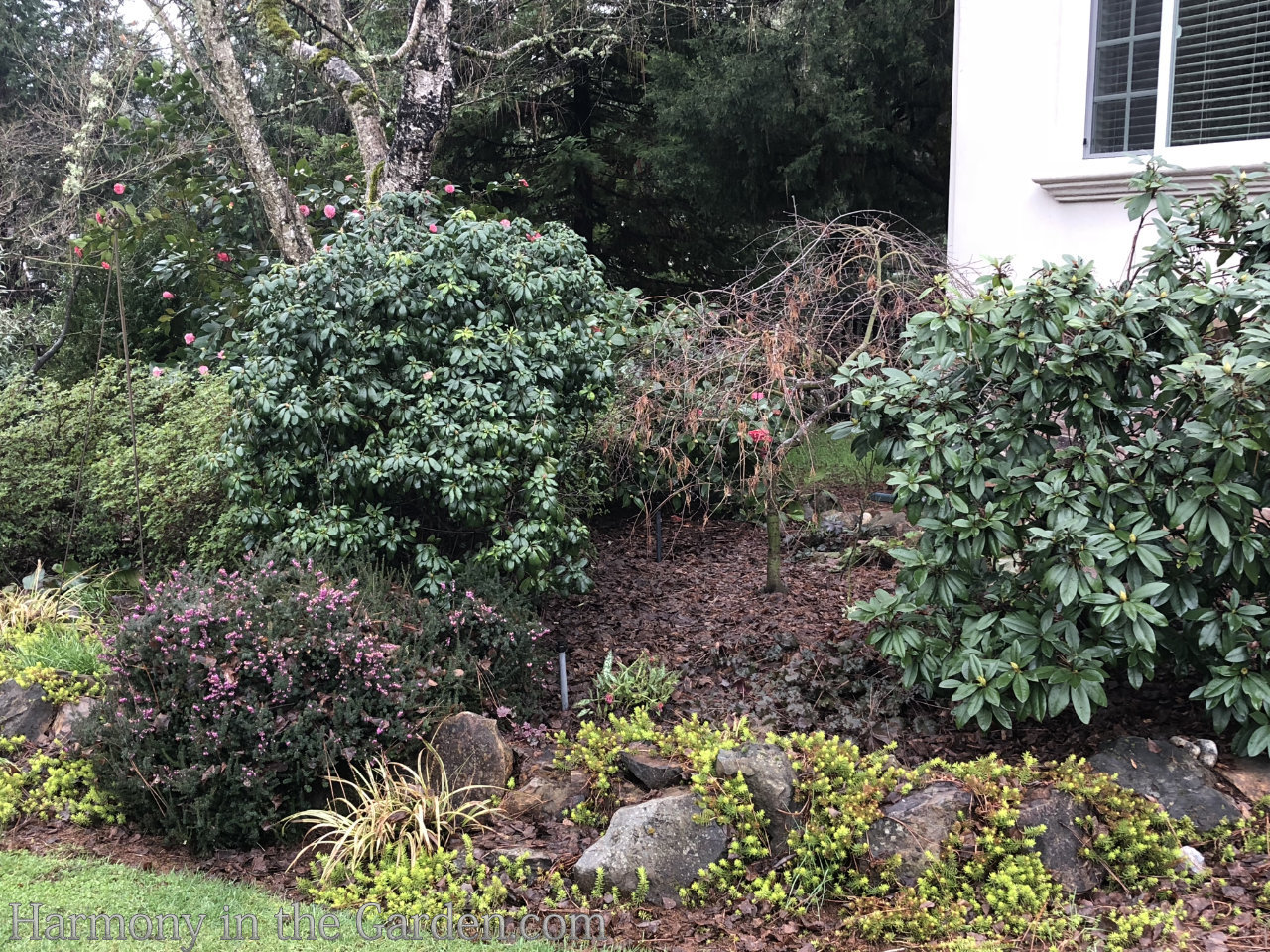
Remember my post about the awkward carport bed? In the example, below, notice how the evergreen plants are providing interest even though the flowering summer perennials are long gone.


One of my favorite shrubs is the ‘Aphrodite’ calycanthus (below) with its oversized apple-green foliage and unusual maroon flowers. In the winter, you can see how I’ve surrounded it with lower-growing evergreen plants to avoid a huge hole in the garden.
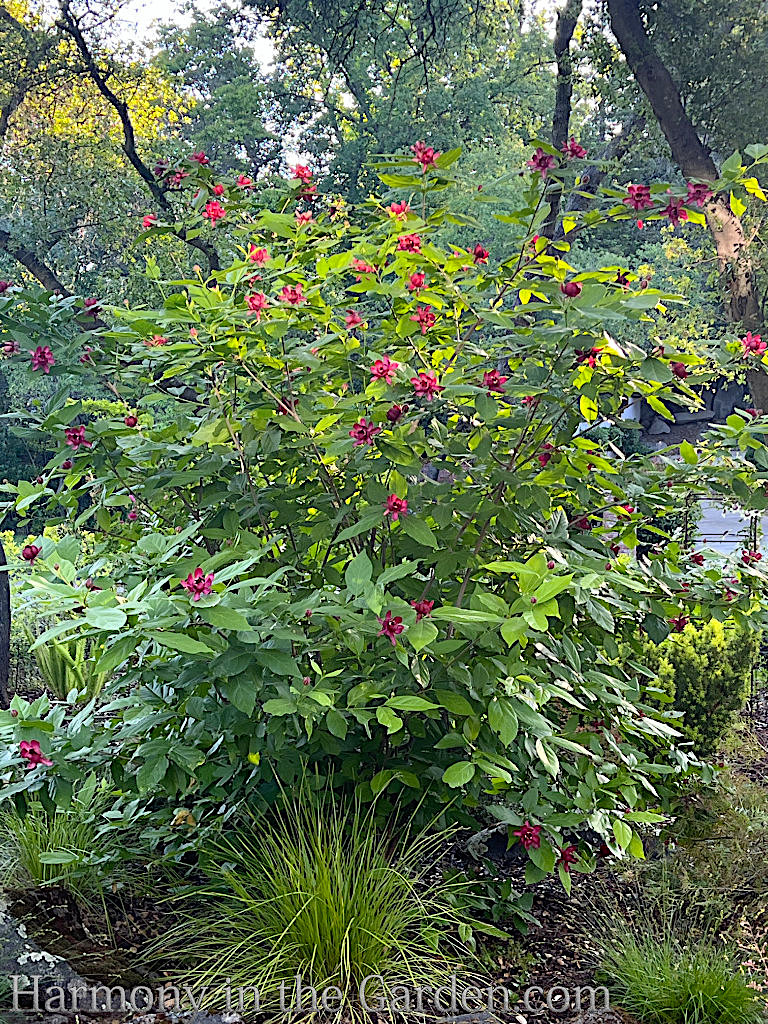

Below is another great example of an evergreen/deciduous combination. The photo on the left was taken in spring, and the photo on the right was taken in February. Note how the blue spruce and evergreen coleonema provide year-round structure and color.
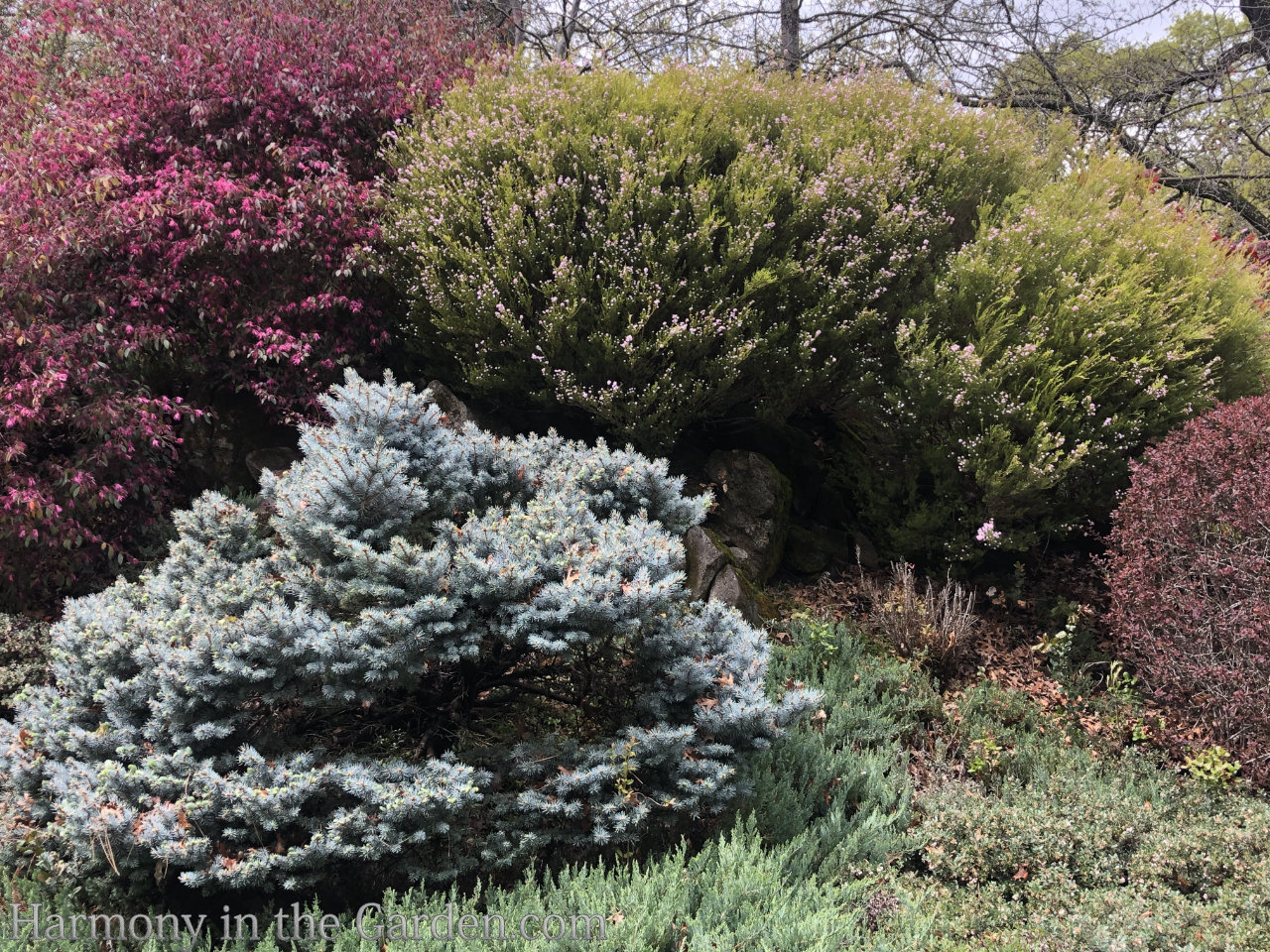
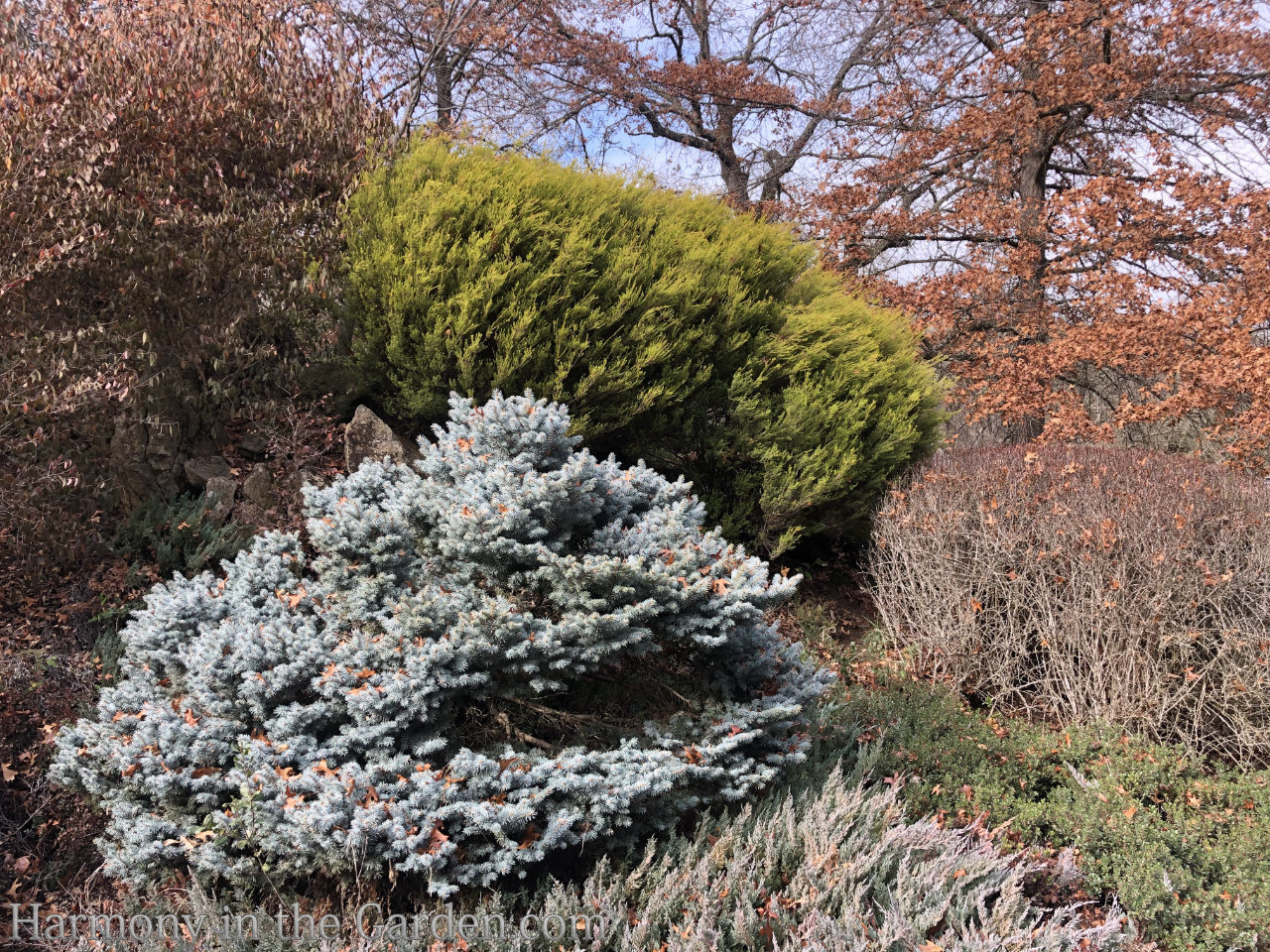

On a much grander scale, note how the deciduous trees are planted in front of the giant evergreens.
The green color of the evergreens not only keep things ‘lush’ looking in winter, but also highlights the shapes of the deciduous trees.
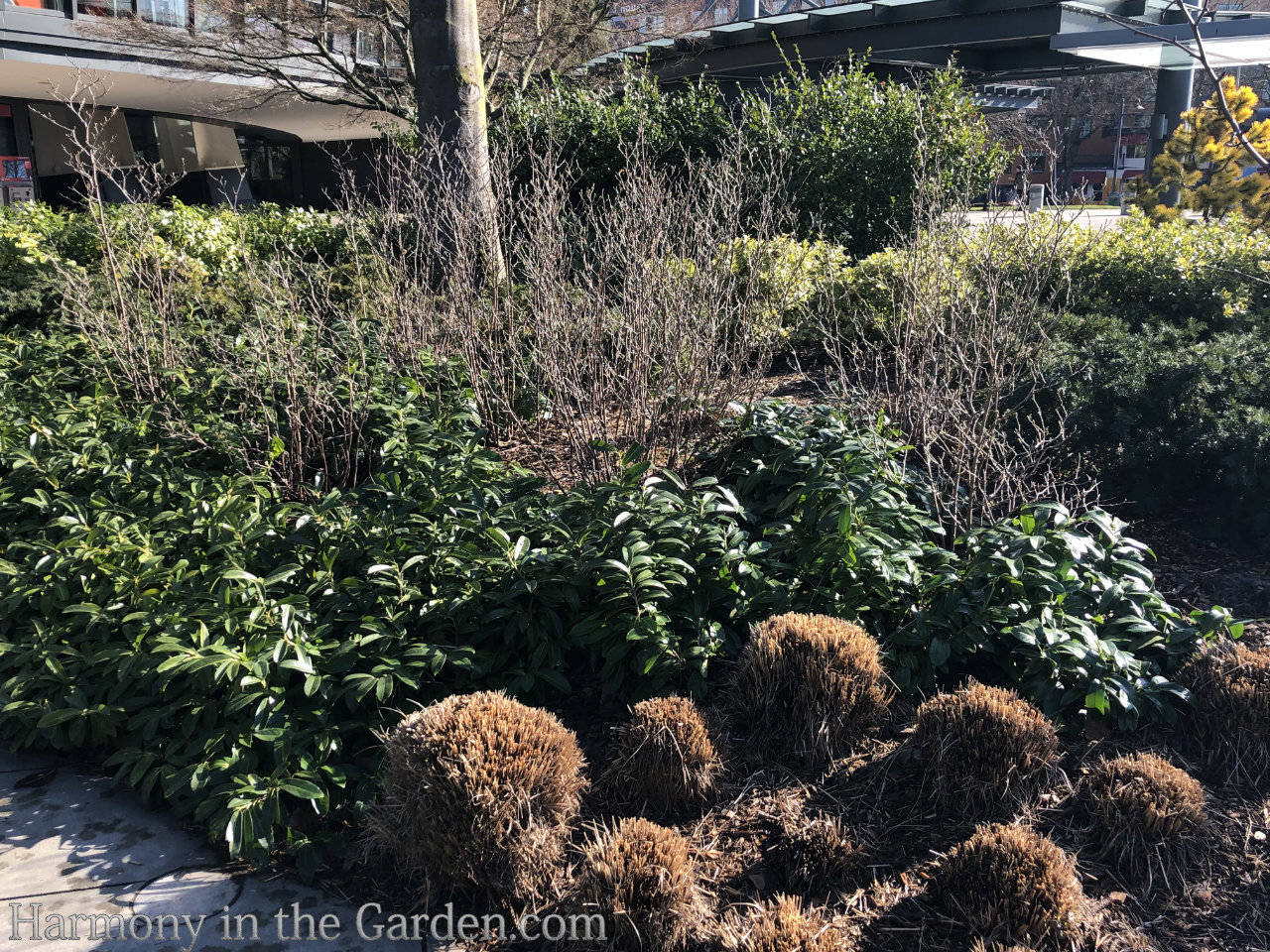
While in Seattle last February, I was visiting the Chihuly Glass & Garden (click here for some jaw-dropping art/plant combinations.)
Just outside of the museum was this recently pruned winter garden bed.
It clearly shows the method of mixing in plenty of evergreen plants between deciduous areas.
They’ve done a fantastic job of preventing a ‘winter moonscape’ from happening!
3. Don’t be so quick to prune spent flowers

I appreciate the subtle beauty of winter’s faded flowers.
Not only because of how warm the tan colors look on a cold, winter day but because many are also a source of winter seeds for birds or places of shelter for hibernating beneficial insects.
A neighbor’s gardener saw me working in my garden last week and told me he’s available for hire as he noticed I have lots of cutting back to do.
When I explained my reasons for leaving my spent hydrangea flowers alone, he looked at me like I was crazy.
I pushed my luck with him and continued to tell him how pretty the shades of brown are in the winter garden, and promptly watched his eyes glaze over.
I doubt he’ll be offering to help again – ha!
One of my favorite before-and-after garden beds is that of my front entry. Even when the fresh lime-green colors of the hydrangea flowers are long gone, the fluffy tan flowers still provide interest.

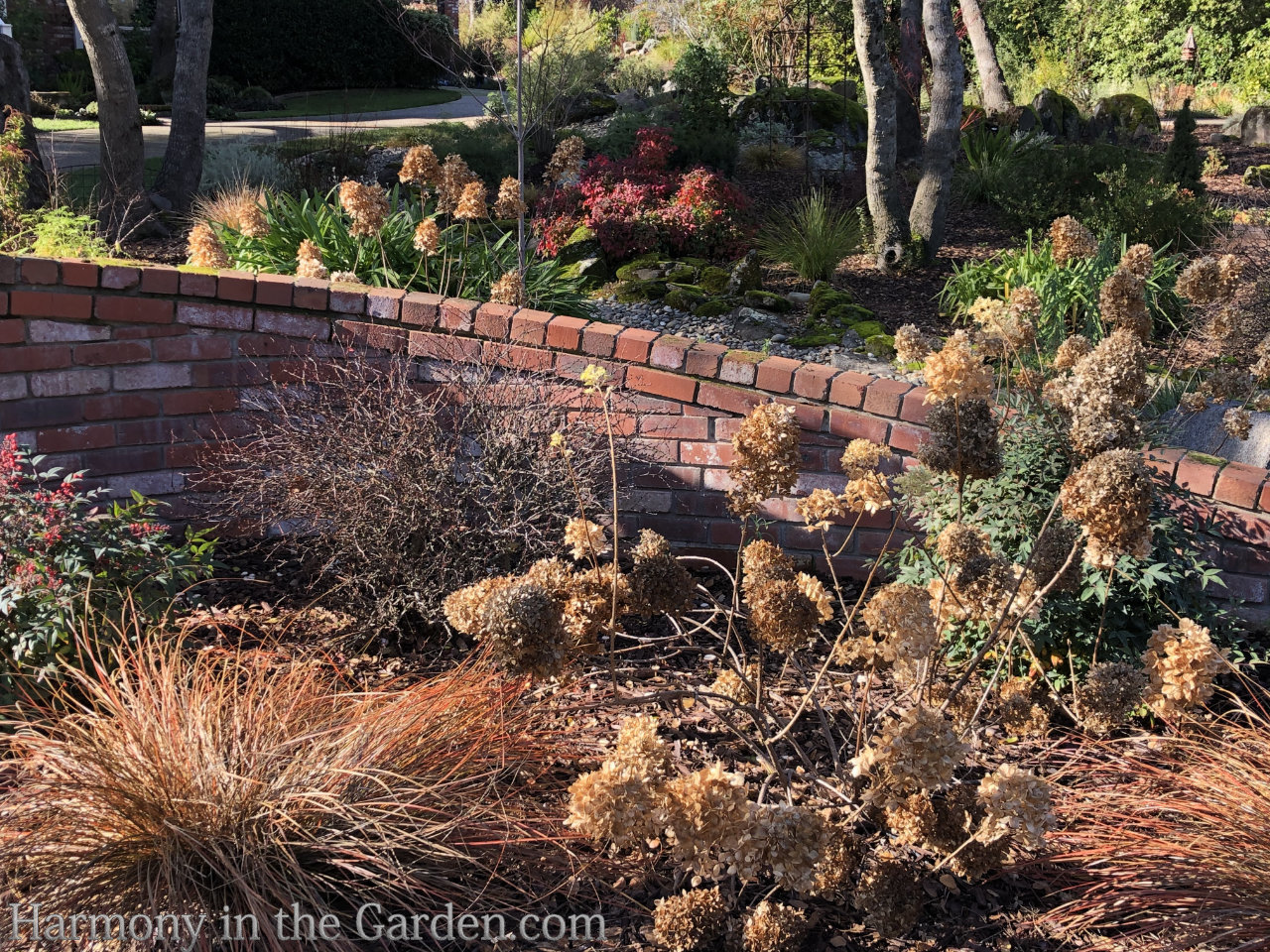
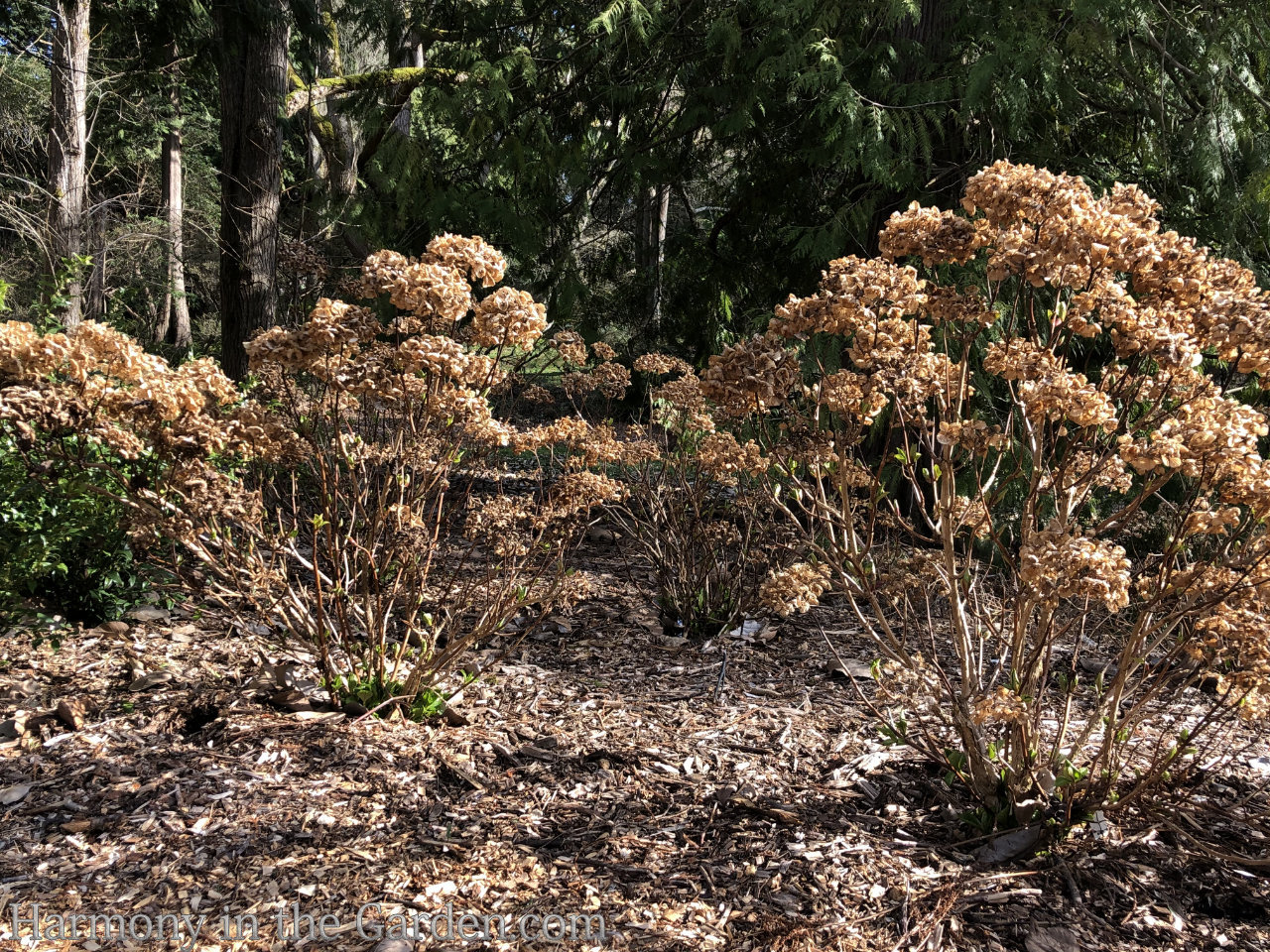
I’m not the only one who leaves hydrangea flowers on as long as possible.
I found these (left) at the Washington Park Arboretum last February. Click the link to see a breath-taking winter garden at its finest!
Of course, faded flowers will need to be pruned once they turn black and begin to fall apart, but my advice is to enjoy them as long as possible!

Other flowers that hold their own against the winter elements are those of the phlomis russeliana (left, sedum ‘Autumn Joy’ (lower right) and even the seedheads of ‘Monch’ aster (lower right.)
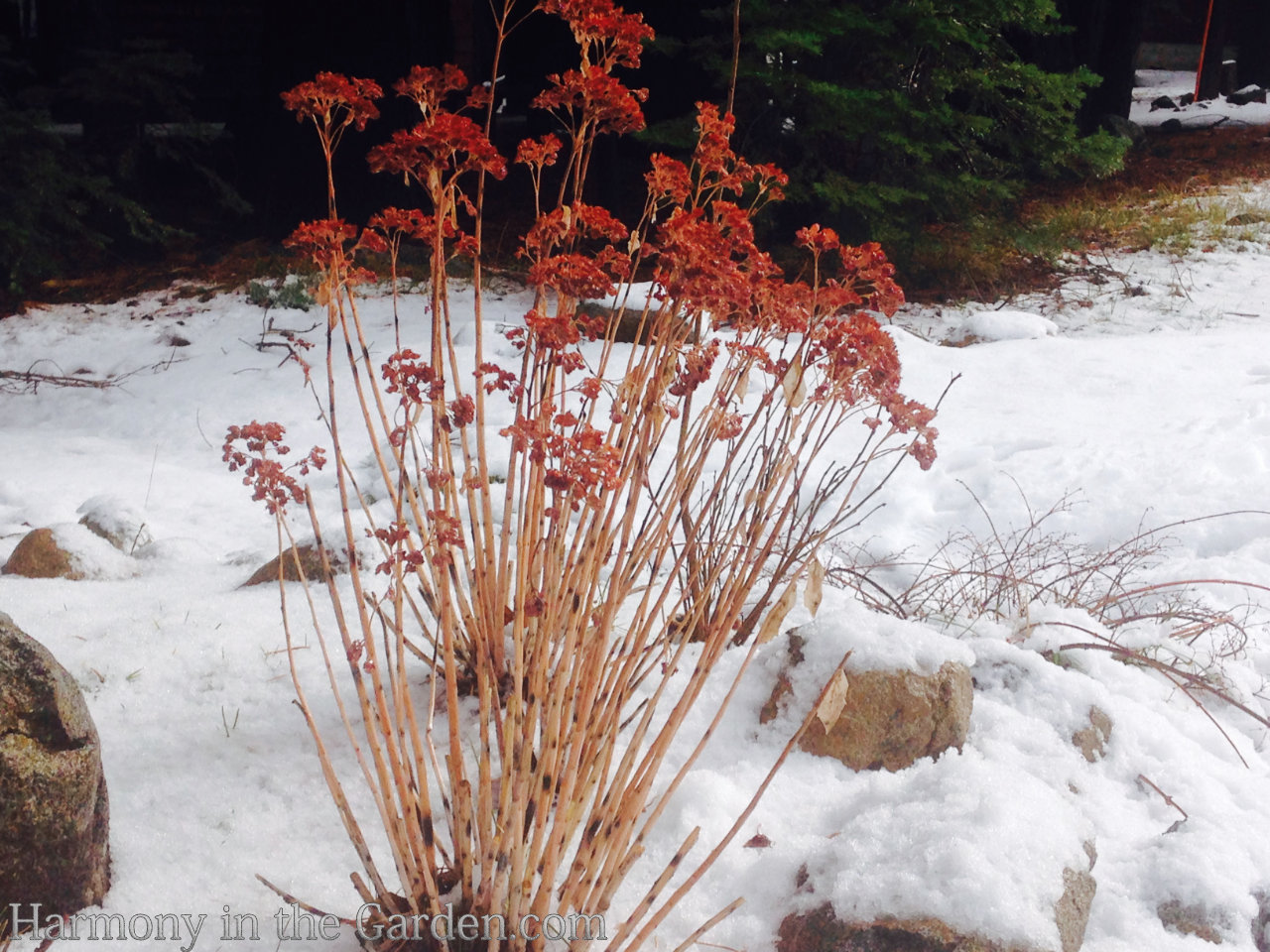


Okay, ready for more ways to create winter interest? Click here for Part 2!
Until next time – happy gardening!






16 Comments
Oh! Thank you, now I see that it is a blue spruce! The photo is small enough on my iPad that it looked like a flowering shrub!
Weird!?
Hi, Rebecca! I love your blog with tips for all-season interest in the garden and have been trying my best to apply your suggestions. I heard you at the Northwest Flower and Garden Show before covid hit, have checked out your books from the library, and as stated above, love your blog.
I have a lovely, well-established, large potted sarcococca that is currently blooming. It is in the back (east) yard up against the house. I was hoping to move this beautiful, fragrant plant up near my front door on the west side of the house where I can more fully enjoy its beauty and scent. However, I just read that it doesn’t do well in full afternoon sun. Can I risk trying it there? Or should I try somewhere else? Perhaps on the side front yard where there is some shelter from the sun? I’m really hoping to put it by the front door or walk, somehow. I live in Bellevue, WA.
Thanks for any help you can give me!
Hi Kathy – I’m so happy you’re enjoying my blog and books! Don’t you just love the scent of a sarcococca? It’s such a welcome thing in the middle of winter! Since Bellevue is MUCH milder than where I live in Granite Bay, you might give it a try by your front door – especially in the winter when it’s blooming. That way, you can appreciate it’s scent and perhaps move it back into the shade once summer arrives? If you decide to keep it there year-round, just be on the lookout for bleached/burned leaves. I have one by my front door, and even though my house is north-facing, the afternoon sun peeks in between the oak trees and in the summer the foliage gets a little tortured. I would think yours would be fine in the winter/early spring months. Fingers crossed!!
Thank you so much for your advice! I like your idea of trying it out by the front door, especially during winter when it is in bloom and keeping a careful eye on it when it gets warmer. This plant is precious to me as I dug it up from my childhood home when my mother passed away in 2016. I love how plants often connect me with loved ones!
I’m so glad you were able to take that meaningful plant with you, Kathy, and I wish you the best of luck with it in its new location (for the winter, at least!)
Thank you!
Rebecca, I am curious about the last photo in your blog. What is that beautiful white blossomed shrub? I’m wondering how it might do here in California’s Central Valley.
Hi Julie – the last photo shows the blue spruce so I’m wondering if you’re referring to the photo above it, which is the perennial ‘Monch’ aster with the dried flowers/seedheads left on. Is that it? The aster would do well in your area with summer water for sure, but it might be too hot for the blue spruce. Depending on where you live I would definitely check it out further, but the aster is a thumbs up.
I too like to keep my hydrangea blooms as long as possible. Not all years seem to work, but this is a good one all around my garden. They can appear almost golden. Love the same pics in different seasons.
You’re so right, Lin, this year has definitely been a good year for faded hydrangeas! I’ve noticed mine are starting to turn black now, so I’m hoping I get another few weeks out of them!
Thought your presentation of Winter Interest in the Garden was wonderfully uplifting. I’m in the Midwest and I too like evergreen – especially in winter. One of the other things I noticed in your various photos of gardens was the moss grown on rocks and trees. I love that and wonder if I can incorporate moss growing on some of my trees. What do you think?
Hi Brenda, I’m so glad you liked this post. I’m incredibly fortunate to have inherited all the existing moss that appears on the stones and trees once there’s a drop of moisture. It’s everywhere in my neighborhood and I feel so lucky to have it appear each winter. I wish I could tell you how you can get the same effect in your own garden, but unfortunately I can’t. I do know, however, there’s info on the internet about growing moss/lichen with homemade mixtures (as I recall buttermilk can often be part of the ingredient.) You might try experimenting a bit to see what works in your climate. I certainly wish you the best of luck and hope you end up with beautiful moss!
Thank You so much for this timely advice as I begin to flesh out my landscape plan in writing. Your photos were very helpful. I’ve just moved into a new home so I have quite a bit of planning and work to do!?
That’s so exciting, Marcia, and I’m so happy I could help! Designing a new garden can be so much fun.
Thanks for the solid advice. Looking at pictures of the same space over time is especially useful.
I look forward to Winter here in our part of the Bay Area because this is when Aloes put up spectacular blooms (and of course because it’s just about the only rain we get). Even though it’s January the blooms still attract pollinators which makes a winter garden feel that much more alive.
You’re so right about that, Hans! That’s such a great point about attracting pollinators in quieter months to keep the garden feeling alive. Thanks for stopping by my blog 🙂